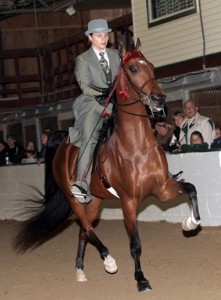I think at some point in life, everyone will encounter at least one horse that seems to despise the curb bit. No matter what bit you try, no matter what you do, the horse goes around with a stiff neck, clenched jaw, and nose straight out. So what are some things you can do to help the horse understand what you’re asking for, and maybe even like the curb bit?

Flexion Work
The first place I start is with flexion. If the horse is not willing and able to flex in a snaffle, both vertically and laterally, it will be almost impossible to get them to flex in a curb bit. Flexion begins where resistance ends, so I like to do a lot of work asking the horse to soften in the jaw and neck.
I ask my horse to flex (NOT turn) to each side with a gentle pull on the reins. I hold that pull steady until the horse releases the tension in their jaw/neck and flexes to the side, and then I release as a reward. Remember, flexion is not the same as turning. You don’t want the horse to turn while doing these exercises (although at first, when they are confused about what you’re asking, they will usually turn). You want the body of the horse to remain straight or with a very mild arc, while the neck becomes loose and the horse’s nose tips to his shoulder. You can start this work while standing still to teach the concept to the horse (a steady pull means tip your nose towards your shoulder, and release as a reward). Gradually work in the flexion at the walk, trot, and finally the canter. Eventually, when the horse is well conditioned to relax his jaw and neck with a slight pull on the rein, you’ll find them much more willing to soften into a curb bit.
Bending Work
Keeping a horse supple through the body by asking them to curve their spine to each side will also help reduce resistance in the jaw and neck. I do this with circles and serpentines of varying sizes. A side benefit of this is that a horse that is paying attention to the rider, ready for any command, and in self-carriage will not be resisting in the bridle.
One of my favorite things to do is what I call a “snake.” It’s a slow, undulating serpentine down the long side of the arena, but the arcs are fairly small, maybe 10′ at the most. As I come around the turn, I’ll ask the horse to continue the bend until we’re about 10′ off the rail, then transition to the opposite bend as we go back towards the rail. I’ll do this down the whole length of the rail, back and forth. The most important part of this exercise is to make sure the horse’s entire body is following the bend – not just their neck. Saddlebreds, with their long necks, are masters of rubbernecking, and if you have a horse that tends to lead with one shoulder, you’ll notice that their haunches will often stay on the same side of their withers, no matter which way you’re bending them. When my horse is stiffer to one side, I’ll often have to make bigger loops one way and smaller the other until he loosens up and can make even arcs.
Circles also help, as long as the horse is bending and not falling through the circle or trailing their haunches outside of the arc. If you’re circling in long lines, you can run the outside line down above the hock to help use it as an outside guide and keep the horse bent.
The video below shows some flexion and bending work while driving.
Impulsion
Unwillingness to wear a curb bit can also stem from too little impulsion. If the horse only displays lack of forward gears while wearing the full bridle, it’s likely that the bit is too strong for the horse, the rider is too strong with the rein aids, or the curb chain is too short or needs to be wrapped. If the horse has little impulsion no matter what bridle it is wearing or how it’s being worked, then it could be either a health/conditioning issue, or it’s a training issue.
If lack of impulsion happens only when wearing the curb, I will usually start with going to milder bits. Milder usually means a mouthpiece with a lower arch (or even no arch) like a mullen, windsucking, or polo bit, a shorter shank, or a longer or wrapped curb chain. However… every horse is unique and there are some out there who are not comfortable with a low/flat port (acts too much on the tongue for their liking) or a longer curb chain (allows the bit to rotate further in the mouth). You have to try various things to find just the right bit for the horse, and once you find the right bit, it might change once your horse learns flexion, how to bend, and how to wear the curb. So the “right bit” isn’t always the right bit forever. 🙂
Rinse and Repeat
And finally, when I have a horse that isn’t fond of the curb bit, I will work them in it often. Traditionally, show horses wear their show bridles infrequently so they don’t get bored with them, and wear just a snaffle of some kind for most workouts. But some horses are the opposite, and almost NEED to get bored with the curb bit in order to wear it well. So I will work a horse like that 3-4 times a week, sometimes even more, in some kind of curb bit. I love to long line and drive in an elevator bit, and I also long line and drive in a curb bit or a liverpool (yes, horses can steer while wearing just a curb bit – but try this in long lines first). I will also ride the horse more frequently in the double bridle than in a work bridle. All in all, basically having the horse work, day in and day out, in the curb will make them more comfortable with it.
With all of that said, where do you start? I would recommend starting at the top of the page, making sure your horse can bend and flex, and that it understands what you’re asking for when you ask for flexion vs. bending/turning. Once you have that in place, then start experimenting with curb bits until you find one where the horse’s jaw remains soft and pliable and you can still get the same flexion upon request. After that, it’s just fine tuning!
- Fixing the One-Sided Horse - March 28, 2016
- Running Martingales, Draw Reins and German Martingales – A Physics Lesson - November 23, 2015
- What to Do in the Off Season - October 14, 2015

Good article Tiffani. I thought of the chiropractor as well as a good first step. Especially if having problems flexing in general.
Very informative, well-written article and video. It’s also important for people to know that resistance in the bridle can be a result of pain, whether in the back, hocks, etc., especially in horses with poor conformation or in poor condition. Consult a veterinarian as needed. All the more reason to buy a horse with good conformation and get a thorough vet check at purchase. Not that I have had any experience with this and learned from my past mistakes. 😉